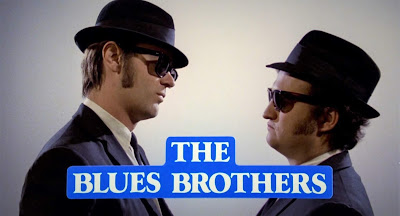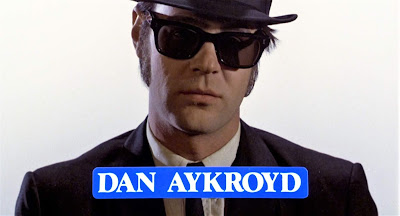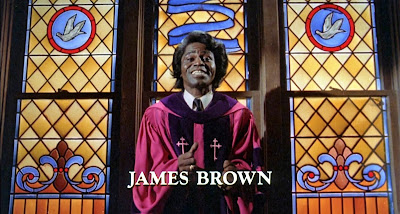The saying goes that no one starts out intending to make a
bad movie. This sounds fine in theory, but the reality is more in line with--no
one starts out intending to make a flop. Hollywood makes bad movies all the time. Sometimes willfully (looking at you, Adam Sandler, Kevin James, & Rob Schneider). They just care when their bad movies don't make money. Who's going to call the blatantly lousy (to me) Fast & Furious movies bad when they rake in so much at the boxoffice?
When boxoffice success becomes the defining standard by which a film is deemed good or bad, creative decisions are ultimately ruled by their marketability and moneymaking potential. And just as there is a subtle, yet significant, difference
between someone wanting to be a great actor vs. someone wanting to be a big star; a movie that starts out intending to be a good film is not (necessarily) coming from the same creative mindset as one that sets out to be the next blockbuster boxoffice
success.
Which brings us to Robert Stigwood's $18-million boondoggle, Sgt. Pepper's Lonely Hearts
Club Band.
 |
| Peter Frampton as Billy Shears |
 |
| Sir Barry Gibb as Mark Henderson |
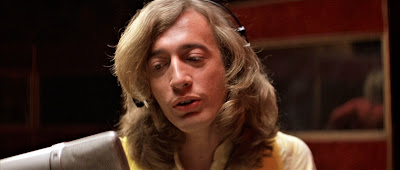 |
| Robin Gibb as Dave Henderson |
 |
| Maurice Gibb as Bob Henderson |
 |
| Dianne Steinberg as Lucy |
 |
| Sandy Farina as Strawberry Fields |
 |
| Donald Pleasence as B. D. "Big Deal" Hoffler ...or Brockhurst, if you go by the film's credits and bubble gum cards |
While it certainly could be argued that with Sgt Pepper, Stigwood was ahead of his
time in presenting what amounts to being the first jukebox musical (Abba's Mamma Mia! was a good two decades to
come), in this instance, the uniqueness of the film's structure proved
considerably less problematic than its execution.
 |
| George Burns as Mr. Kite |
Drench in a garish, cocaine-color-palette
reminiscent of a Sid & Marty Krofft kiddie show; blend in diluted, American
Bandstand-friendly arrangements of a catalog of 29 Beatles songs culled from their
most innovative albums: Sgt. Pepper's
Lonely Hearts Club Band, Rubber Soul,
Magical Mystery Tour, Revolver, Abbey Road. Ultimately mold into an inchoate fantasy adventure told
entirely in song; tack on superfluous narration so soporific it makes Don
Kirshner sound caffeinated by comparison, and voilà-- Sgt. Pepper's Lonely Hearts Club Band: The Movie.
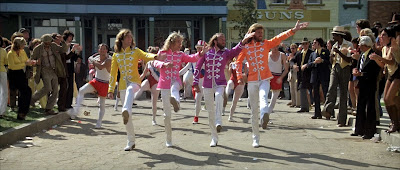 |
| "A Splendid Time is Guaranteed for All!" This lyric from "Being for the Benefit of Mr. Kite" was used as the film's promotional tagline and later came to bite the movie on the ass |
Set in the fictional town of Heartland, USA, Sgt. Pepper's Lonely Hearts Club Band (hereafter
referred to as SPLHCB) is a musical fable about a wholesome boy band and their
magical musical instruments (regrettably, Freddy the Flute fails to make an
appearance). Conflict,
such as it is, is introduced in the form of an oily music producer named B. D. Hoffler (Donald Pleasence), who interrupts the band's bucolic braying long enough to whisk them off to Los Angeles, where they are to be corrupted by the temptations of sex, drugs, and wealth.
The group's departure allows an organization called F.V.B. (Future Villain Band, played by Aerosmith) to steal the magical musical instruments, which in turn hastens the decline of Heartland, now taken over by an overacting real estate agent named Mr. Mustard (gay British comic Frankie Howerd, who makes Tommy Steele and Zero Mostel look laid-back). The rest of the film is devoted to the Heartland boyband's efforts to retrieve the instruments and save their hometown.
The group's departure allows an organization called F.V.B. (Future Villain Band, played by Aerosmith) to steal the magical musical instruments, which in turn hastens the decline of Heartland, now taken over by an overacting real estate agent named Mr. Mustard (gay British comic Frankie Howerd, who makes Tommy Steele and Zero Mostel look laid-back). The rest of the film is devoted to the Heartland boyband's efforts to retrieve the instruments and save their hometown.
 |
| Paul Nicholas as Dougie Shears |
By way of a love interest and virginal heroine, we have newcomer Sanday Farina (a kind of bargain-basement Ronee Blakley with a lovely voice) as Strawberry Fields. For femme fatale contrast, there's newcomer and just-as-quickly newgoner Dianne Steinberg as Lucy, a sexy pop singer backed up by The Diamonds, portrayed that
'70s R&B trio you forgot to forget, Stargard (their 1976 hit "Wear it Out" is really pretty good).
British actor/singer Paul Nicholas adds to his growing screen resume of unscrupulous creeps playing one of Pepperland's few rotten apples. Iconic "fifth Beatle" Billy Preston, cast as a magical weather vane, is saddled with what can safely be described as the apotheosis of the Magical Negro trope. And last but not least, we have a pair of curvaceous female robots called The Computerettes (yep, you read that right) aiding and abetting Mr. Mustard and sundry "guest villains."
British actor/singer Paul Nicholas adds to his growing screen resume of unscrupulous creeps playing one of Pepperland's few rotten apples. Iconic "fifth Beatle" Billy Preston, cast as a magical weather vane, is saddled with what can safely be described as the apotheosis of the Magical Negro trope. And last but not least, we have a pair of curvaceous female robots called The Computerettes (yep, you read that right) aiding and abetting Mr. Mustard and sundry "guest villains."
Even by '70s standards, this was some weird-ass shit.
But, as Ken Russell spectacularly proved in bringing The Who's
equally bonkers Tommy (1975) to the screen,
a hallucinatory rock-opera with no spoken dialogue and a preposterous plot can
be made to work. Provided it's done with some talent and ingenuity. Alas, with
SPLHCB, little of either is in evidence.
 |
| Frankie Howerd as Mean Mr. Mustard |
 |
| The emblem of fictional record magnate B.D. Hoffler (r.) spoofs the logo of the Robert Stigwood Organization (which is a good luck Japanese toy cow called an akabeko) |
I have a hunch that Stigwood had the same kind of micromanaging hand in this film's production as Allan Carr had on the similarly calamitous Can't Stop the Music two years later (you don't hand over a $20m-million production to Rhoda's mother because she's experienced, you do it so you can control her). I say this because SPLHCB is so undistinguished in execution and so indifferently shot, I'm at a severe loss as to know what talented director Michael Schultz (Cooley High, Car Wash) brought to the mix. The film looks like a Kaptain Kool & the Kongs TV special.
 |
| Steve Martin as Dr. Maxwell Edison |
THE STUFF OF DREAMS
In fashioning a musical with no spoken dialogue but extensive, expository voice-over narration, SPLHCB is an unhappy-alliance hybrid. A combination of sung-through
musicals like Evita, Hamilton, The Umbrellas of Cherbourg, and Jesus
Christ Superstar, and jukebox musicals like Mamma Mia! (ABBA), The Boy
From Oz (Peter Allen), and—ironically enough—the 1998 stage production of Saturday Night Fever, which combined songs
from the Bee Gees music catalog with songs from the film's soundtrack.
 |
| Earth, Wind & Fire had a #1 Soul Charts hit with their version of "Got to Get You Into My Life" |
The stringing together of unconnected Beatles songs to form
a narrative is a dicey endeavor at best (something accomplished with considerable
charm in the 1968 animated feature film Yellow
Submarine). But to attempt to do so without expressive actors able to
convey complex emotions (Ann-Margret and Oliver Reed in Tommy) or forceful musical personalities who grow more vividly "present"
and alive in performance mode (Michael Jackson and Mick Jagger come to mind) is
a fool's errand. Indeed, one that music journalist turned first-time
screenwriter Henry Edwards could not overcome in fashioning the screenplay/story for
SPLHCB.
The classic, Candide-like structure of The Who's Tommy was ideally suited to Roger Daltrey's blank-slate countenance, presenting him as a relatable everyman beset by harrowing encounters with bizarre characters on his journey to spiritual enlightenment. Unfortunately, SPLHCB takes a plot straight out of an episode of The Adventures of Rocky and Bullwinkle (replace the stolen Sgt. Pepper instruments with a Mooseberry bush) but gives us heroes too bland to identify with, a low-stakes adventure that's hard to care about, and villains who shoot for outrageous and funny, only to land at embarrassing and hammy.
 |
| Alice Cooper as Father Sun, nee Marvin Sunk |
This leaves all the film's heavy-lifting to the Beatles
tunes themselves, which are a pretty fantastic lot, and generally well-performed...if not memorably. George Martin, producer of all but one of the Beatles' original
records, was the film's musical director, but this didn't prevent the release of the double LP soundtrack album (arguably the only reason the film was made at all) from being a colossal flop. Copies of the soundtrack were found in remainder bins almost before the summer was over.
PERFORMANCES
Anyone who's ever seen the Gibb brothers together on
a TV talk show knows how self-deprecating and engagingly funny they can be. On one
such program, when asked to come up with Spice Girl-type names for themselves,
they answered: Beardy Bee Gee, Teethy Bee Gee, and Baldy Bee Gee. They came across as relaxed, quick to laugh, and highly likable. Alas, none of these qualities are in evidence in SPLHCB. Uncomfortable and self-conscious, the constriction of their too-tight costuming seems to transfer to their performances. Granted, none of them are really given characters to play,
but Schultz never finds a way to bring out the brothers' natural charm and relaxed rapport.
Even their vocal performances sound hemmed-in.
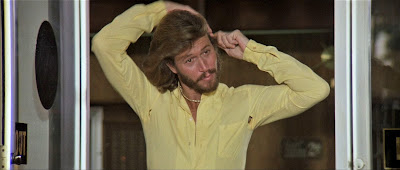 |
| Positively Ripping Gibb is bustin' out all over in this shot reminding us that wearing those form-fitting disco shirts of the '70s (fine for dancing The Hustle) came at a risk |
Frampton mostly looks uncomfortable and seems like he wishes Andy Gibb would step in at any moment and take his place. (He
never really recovers from how he's introduced in the film: wearing a pink
shirt under stark-white, tapered overalls embroidered with a big red flower
and the name "Billy"…he looks like the world's tallest, lankiest toddler.) But, of course, I do love the scene where he's supposed to be distraught, and tears stream
down his face from his temples and forehead.
 |
| Dianne Steinberg and Paul Nicholas make a fun pair of double-crossers. Too bad the over-busy script never allows their villainy to take root. |
WHAT I LOVE ABOUT THIS FILM
As much as it pains me to admit it, there was a time I
really loved this movie (I still do, but I'm speaking of a time when I actually
enjoyed it unironically). In my defense, SPLHCB was released a mere four weeks
after I'd moved to LA, and I was still heady with the degree of hoopla Tinseltown could unleash when promoting a movie. The publicity push for SPLHCB was enormous,
and it was hard not to get swept up in the circus-like atmosphere. In the summer of 1978, disco was king, the Bee
Gees were riding high on the phenomenon of Saturday Night Fever (it had opened a mere six months earlier),
Frampton was all over the radio, and Steve Martin was THE up-and-coming comic
sensation.
I saw the film the day it opened at the Pacific Theater on
Hollywood Boulevard. Thinking back, it's remarkable to think I had to stand in line to get in. The hyped-up audience was really in the spirit and they laughed loudly and readily. Applause even broke out when Billy Preston made his appearance.
 |
| Billy Preston as Sergeant Pepper (the weather vane, anyway) |
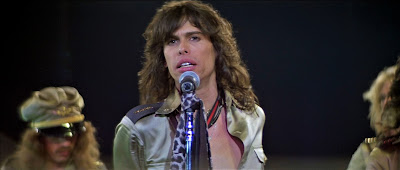 |
| Steven Tyler and Aerosmith as Future Villain Band |
 |
| Careers and reputations were decimated by the film's flop reception, but by all accounts the cocaine flowed freely, so at least I hope everyone involved enjoyed a splendid time. |
BONUS MATERIAL
Filmmaker Michael Schultz was Robert Stigwood's first choice to direct the film Grease. When hired for Sgt. Pepper's Lonely Hearts Club Band, Schultz became the first African-American to helm a big-budget musical. Unfortunately, his feature film career took a hit when SPLHCB flopped so tremendously, taking several other careers with it). But Schulz continues to work steadily in television and, in 1991, was inducted into The Black Filmmakers Hall of Fame.
 |
| One of two prop trumpets created for the film by Dominic Calicchio is housed at the National Music Museum in Vermillion, SD. An eBay auction purchase donated by Allan R Jones. (Image: SFTrips.com) |
 |
| The solo albums by Dianne Steinberg (1977) and Sandy Farina (1980) failed to cause much of a ripple in the music industry |
 |
| Standing 6'3" and made of plaster over a fiberglass frame, the Sgt. Pepper weather vane was sold at auction for $1,265 in 2012. |
Copyright © Ken Anderson 2009 - 2019






